Estrogen-related receptor alpha directs peroxisome proliferator-activated receptor alpha signaling in the transcriptional control of energy metabolism in cardiac and skeletal muscle
- PMID: 15456881
- PMCID: PMC517878
- DOI: 10.1128/MCB.24.20.9079-9091.2004
Estrogen-related receptor alpha directs peroxisome proliferator-activated receptor alpha signaling in the transcriptional control of energy metabolism in cardiac and skeletal muscle
Abstract
Estrogen-related receptors (ERRs) are orphan nuclear receptors activated by the transcriptional coactivator peroxisome proliferator-activated receptor gamma (PPARgamma) coactivator 1alpha (PGC-1alpha), a critical regulator of cellular energy metabolism. However, metabolic target genes downstream of ERRalpha have not been well defined. To identify ERRalpha-regulated pathways in tissues with high energy demand such as the heart, gene expression profiling was performed with primary neonatal cardiac myocytes overexpressing ERRalpha. ERRalpha upregulated a subset of PGC-1alpha target genes involved in multiple energy production pathways, including cellular fatty acid transport, mitochondrial and peroxisomal fatty acid oxidation, and mitochondrial respiration. These results were validated by independent analyses in cardiac myocytes, C2C12 myotubes, and cardiac and skeletal muscle of ERRalpha-/- mice. Consistent with the gene expression results, ERRalpha increased myocyte lipid accumulation and fatty acid oxidation rates. Many of the genes regulated by ERRalpha are known targets for the nuclear receptor PPARalpha, and therefore, the interaction between these regulatory pathways was explored. ERRalpha activated PPARalpha gene expression via direct binding of ERRalpha to the PPARalpha gene promoter. Furthermore, in fibroblasts null for PPARalpha and ERRalpha, the ability of ERRalpha to activate several PPARalpha targets and to increase cellular fatty acid oxidation rates was abolished. PGC-1alpha was also shown to activate ERRalpha gene expression. We conclude that ERRalpha serves as a critical nodal point in the regulatory circuitry downstream of PGC-1alpha to direct the transcription of genes involved in mitochondrial energy-producing pathways in cardiac and skeletal muscle.
Figures

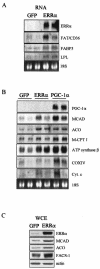
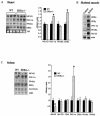
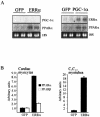
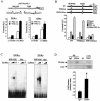
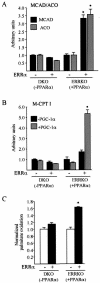

References
-
- Barger, P. M., A. C. Browning, A. N. Garner, and D. P. Kelly. 2001. p38 MAP kinase activates PPARα: a potential role in the cardiac metabolic stress response. J. Biol. Chem. 276:44495-44501. - PubMed
-
- Bernal-Mizrachi, C., S. Weng, C. Feng, B. N. Finck, R. H. Knutsen, T. C. Leone, T. Coleman, R. P. Mecham, D. P. Kelly, and C. F. Semenkovich. 2003. Glucocorticoid induction of hypertension and diabetes is PPAR-α dependent in mice. Nat. Med. 9:1069-1075. - PubMed
-
- Brandt, J., F. Djouadi, and D. P. Kelly. 1998. Fatty acids activate transcription of the muscle carnitine palmitoyltransferase I gene in cardiac myocytes via the peroxisome proliferator-activated receptor α. J. Biol. Chem. 273:23786-23792. - PubMed
Publication types
MeSH terms
Substances
Grants and funding
LinkOut - more resources
Full Text Sources
Other Literature Sources
Molecular Biology Databases
